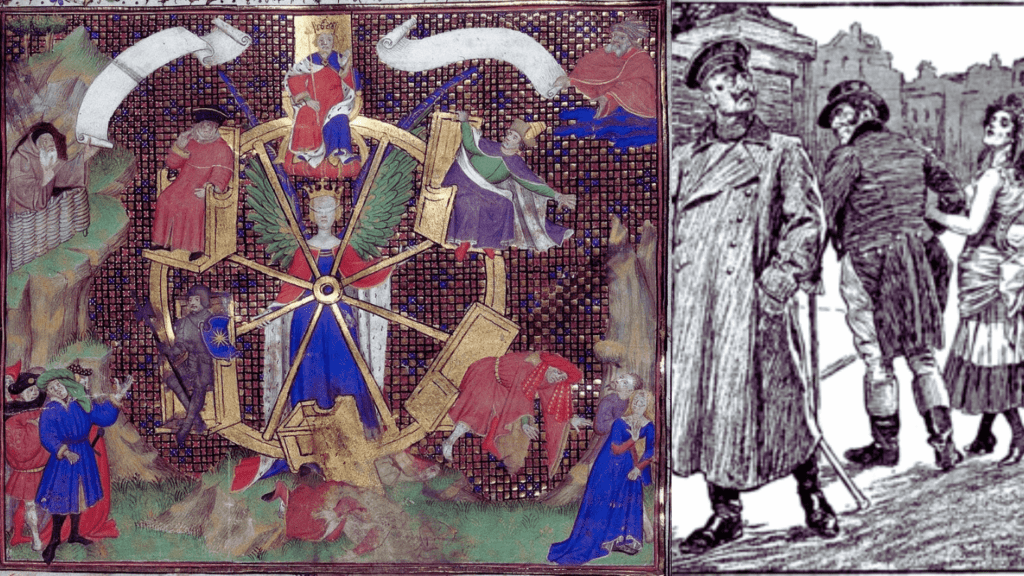Personification is a literary device used to attribute human qualities and characteristics to non-human entities or inanimate objects. This technique is employed to create vivid imagery or to convey sentiments in a way that readers can easily relate to. By assigning human traits to objects or other non-human things, authors can enhance emotional appeal and connect deeper with their audience. For instance, saying “the wind whispered through the trees” personifies the wind by attributing it to the human action of whispering, which can evoke a specific atmosphere or emotion in the narrative.
Understanding Personification
Origins of Personification

Personification has been a significant literary device throughout history, deeply rooted in ancient cultures and literary traditions. The use of personification can be traced back to ancient Rome, where it was prevalent in various forms of art, including coins, where virtues like liberty and cities were personified to embody their importance and influence. This technique was not only a stylistic choice but also served to make abstract concepts more relatable and tangible to the public, thereby enhancing the communicative impact of art and literature.
In literature, personification has been a tool to breathe life into inanimate objects and abstract ideas, allowing writers to express complex ideas in more relatable terms. This approach helps bridge the emotional and sensory gap between the reader and the text, making the literary work more engaging and memorable.
Why Use Personification?
Personification is employed in writing for several compelling reasons:
- Enhancing Relatability: By giving human characteristics to inanimate objects or abstract concepts, personification makes ideas more tangible and easier for readers to relate to. This connection is achieved by tapping into the audience’s senses and experiences.
- Expressing Complexity: Personification allows writers to describe complex abstractions in simpler, more human terms, which helps convey deeper meanings more clearly.
- Boosting Emotional Engagement: The use of personification can increase emotional intensity, making the narrative more vivid and enhancing the reader’s emotional and sensory engagement.
- Improving Imagery and Visualization: It serves as a powerful tool to paint more vivid pictures in the mind of the reader, enriching the visual imagery of the text.
By humanizing elements within a text, personification enriches the narrative, making abstract concepts more accessible and the literary work more engaging and memorable.
Examples of Personification
Personification in Literature

Personification is widely used in both poetry and prose to breathe life into non-human subjects. Here are notable examples from both genres:
Poetry:
- Emily Dickinson: In her poem, Dickinson writes, “She sweeps with many-colored brooms,” personifying nature as a woman who cleans the skies.
- William Blake: In “Two Sunflowers Move in the Yellow Room,” Blake gives sunflowers human qualities, imagining them moving inside a room, which infuses them with vitality and intention.
Prose:
- General Use: In many science fiction novels, inanimate objects such as books are often described as companions, attributing to them the loyal and supportive qualities typically associated with friendship.
These examples show how personification can be used creatively across different literary forms to enhance imagery and evoke a deeper connection with the audience.
Personification in Advertising
Personification in advertising is a creative strategy that attributes human characteristics to non-human elements such as objects, brands, or abstract ideas. This approach enhances communication, makes ads more engaging, and helps create emotional connections with the audience. Here are some ways personification is effectively used in commercials and advertising:
- Enhancing Brand Personality: By personifying brands or products, advertisers can forge a more relatable and human-like image, making it easier for consumers to connect emotionally and remember the brand.
- Promoting Products: Creative ads often use personification to illustrate the benefits or unique features of a product. For instance, personifying car parts as characters in a narrative helps highlight their functions and importance.
- Improving Ad Effectiveness: Research suggests that personification can enhance ad performance by making the messages more engaging and easier to relate to, which can lead to better consumer recall and positive brand attitudes.
- Visual and Emotional Appeal: Personification can transform abstract concepts into visually appealing and emotionally stimulating stories, which are more likely to capture and hold the viewer’s attention.
In summary, personification in advertising leverages the human tendency to empathize with human-like characters, making it a powerful tool for marketers to enhance communication and connect with their audience.
Personification in Everyday Language
Personification is widely used in everyday language to add vividness and emotional depth to expressions. Here are some common phrases and idioms that feature personification:
- “The city that never sleeps”: This phrase personifies a city as a being that never sleeps, suggesting its continuous activity and vibrancy.
- “Howling wind”: This expression gives the wind a human capability (howling), implying a loud and mournful noise, often associated with storms.
- “The sun smiled down on us”: This idiom personifies the sun as smiling, suggesting warmth and pleasant weather, giving a positive mood to the scene.
- “Actions speak louder than words”: While indirectly personifying actions as capable of speaking, this phrase emphasizes that what people do shows more about their intentions and character than what they say.
These examples illustrate how personification can make language more engaging and relatable by attributing human qualities to non-human elements.
How to Create Personification
Choosing the Right Subject
When selecting a subject for personification in your writing, consider the following tips to enhance the effectiveness and appeal of your narrative:
- Identify the Subject: Choose a non-human subject or object that you wish to give human traits to. This could be anything from elements of nature like trees or the ocean to objects like books or houses, or even abstract concepts like death or happiness.
- Theme Relevance: Ensure the subject you choose to personify aligns with the theme of your piece. This coherence helps to reinforce the message or mood you intend to convey through your writing.
- Concept Suitability: Some concepts naturally lend themselves more to personification. Select concepts that can easily be imagined with human characteristics, as this will make your personification more vivid and relatable.
- Purpose of Personification: Decide on the purpose of using personification. Whether it’s to evoke emotion, provide clarity, or enhance imagery, the reason behind personifying an object should guide your choice.
- Show, Don’t Tell: Use personification to show emotions and actions rather than just telling them. This helps in creating a more immersive and expressive narrative.
By following these tips, you can effectively choose subjects that enrich your writing through personification.
Matching Actions to Subjects
To effectively assign human actions to non-human subjects in your writing, consider the following guidelines for using personification:
- Choose Appropriate Actions: Assign actions that metaphorically fit the nature or characteristics of the non-human subjects. For instance, saying “the wind whispered through the trees” attributes a human action (whispering) that is consistent with what the wind can metaphorically do.
- Enhance Descriptive Effect: Use personification to enhance your descriptions by choosing actions that help create vivid images or convey emotions. For example, “the sun smiled down on us” provides a comforting, warm image of the sun.
- Maintain Consistency: Ensure that the actions you attribute are consistent throughout your piece. If the sun is ‘smiling’ early in your text, keep the sunny disposition consistent unless there is a narrative reason for change.
- Align With Theme: The actions chosen should align with the overall theme or mood of the piece. Personification can be a powerful tool to reinforce the thematic elements of your writing.
By following these tips, you can effectively use personification to make your writing more engaging and imaginative.
Crafting a Personified Sentence
Creating a personified sentence involves attributing human qualities or actions to non-human entities or inanimate objects. Here’s a step-by-step guide to crafting an effective personified sentence:
- Select a Non-Human Subject: Choose the object or element you want to personify. For example, “the car”.
- Assign a Human Trait or Action: Think of a human trait or action that metaphorically fits the non-human subject. For instance, we can assign the action of “sleeping” to the car.
- Craft the Sentence: Combine the subject and the human trait to form a complete thought that gives life to the subject. Therefore, you could write, “The car slept in the garage, its breath steady and quiet as the night deepened.”
This sentence personifies the car by giving it the human action of sleeping, suggesting it rests at night like a person might.
The Impact of Personification
Emotional Connection
Personification can significantly deepen the emotional connection between a reader and the text. By attributing human characteristics to inanimate objects or abstract concepts, personification makes the non-human relatable and evokes empathy from the reader. This technique:
- Enhances Emotional Resonance: Giving human traits to non-human entities helps evoke specific emotions like sympathy, fear, or joy, thereby making the reading experience more engaging and memorable.
- Builds Vivid Imagery: Personification can create more vivid, imaginative scenarios that help the reader visualize concepts and scenes more effectively, thus enhancing their emotional connection to the material.
- Fosters a Sense of Familiarity and Empathy: By humanizing elements of the text, readers find it easier to relate to and understand the emotions being conveyed, fostering a sense of empathy and shared experience.
- Strengthens Theme and Message: Through emotional engagement, personification can also reinforce the themes or messages of a piece, making them more impactful and resonant with the audience.
These aspects of personification not only make the narrative more compelling but also establish a stronger emotional bond between the reader and the text.
Enhancing Imagery and Engagement
Personification plays a crucial role in enhancing imagery and engaging audiences in literary and artistic works. This technique involves attributing human qualities to non-human objects or abstract ideas, which helps in several key ways:
- Enhancing Descriptions: By giving human traits to objects or concepts, personification allows for more vivid and relatable descriptions. This enriches the text and makes the imagery more compelling.
- Creating Emotional Connections: Assigning human characteristics to non-human elements can evoke a stronger emotional response from the audience. This connection is vital in engaging readers or viewers on a deeper emotional level.
- Improving Reader Engagement: Personification can make the text more lively and interesting, thereby maintaining the reader’s interest and enhancing overall engagement.
- Supporting Thematic Expression: By personifying elements, writers can more effectively express themes and abstract ideas, making them easier for the audience to understand and relate to.
These effects of personification not only create a more vivid narrative but also strengthen the connection between the work and its audience.
Challenges of Using Personification
Using personification effectively poses several challenges, which can impact the clarity and emotional impact of writing. Here are common pitfalls to watch out for:
- Clarity of Emotion: One of the main challenges is ensuring it’s clear what the personified object is feeling or representing. Writers often struggle to convey precise emotions through personified objects, which can lead to confusion or ambiguity in the narrative.
- Overuse: Excessive use of personification can dilute its effect, making the writing feel forced or overly sentimental. This is particularly evident in the critique of ‘pathetic fallacy,’ where overuse can make the environment feel overly dramatic or unrealistically aligned with the protagonist’s emotions.
- Appropriateness: Not every context is suitable for personification. In some settings, particularly in formal or technical writing, using personification can seem out of place and reduce the seriousness of the content.
- Emotional Resonance: Effective personification requires a fine balance to ensure that the emotions attributed to inanimate objects or concepts do not appear trivial or misplaced. This requires a deep understanding of the emotions one intends to evoke, which can be particularly challenging when dealing with complex or subtle feelings.
These challenges require careful consideration and skillful writing to ensure that personification enhances rather than detracts from the work.
Conclusion
Personification stands as a pivotal literary device, infusing life and human characteristics into non-human elements, inanimate objects, or abstract concepts. This technique enhances the relatability and vividness of literary works, allowing readers to forge deeper emotional connections with the narrative. Employing personification not only animates the description but also serves as a powerful tool for expressing complex ideas and emotions more intuitively. While its utilization requires skill to avoid pitfalls like overuse or ambiguity, when executed adeptly, personification enriches the text, making abstract or mundane aspects engaging and perceptible on a human level.
Read also: How to Get Rid of Mold on Walls




